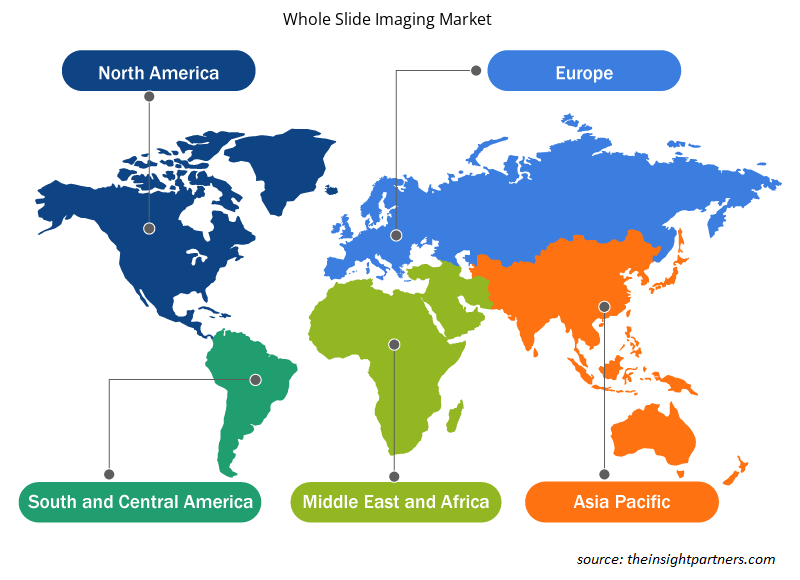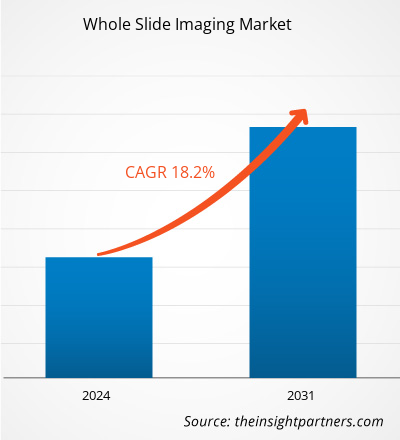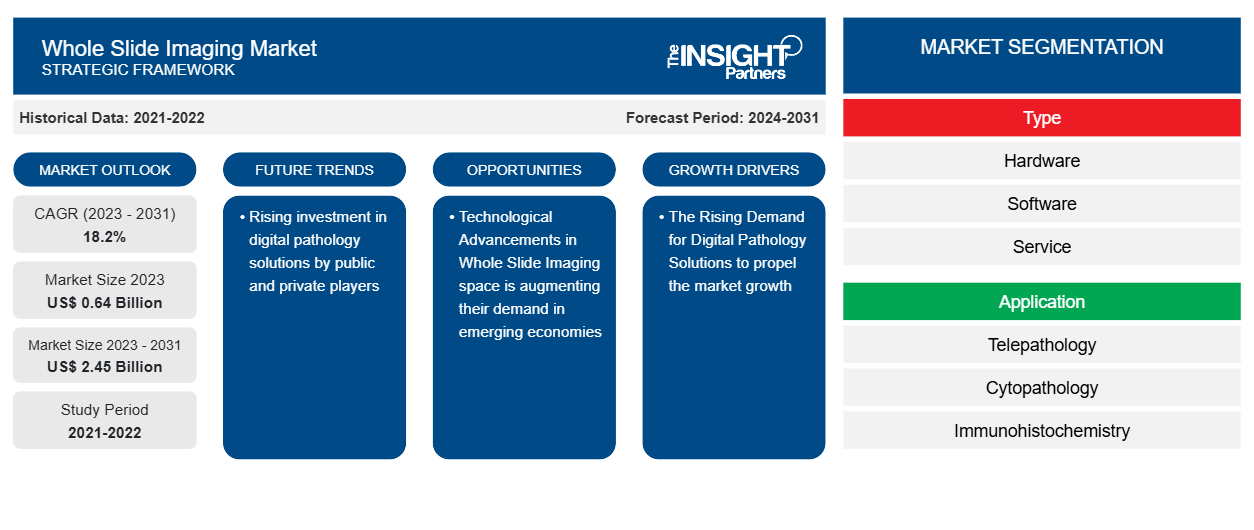Si prevede che l'intero mercato dell'imaging di diapositive raggiungerà i 2,45 miliardi di dollari entro il 2031, rispetto ai 0,64 miliardi di dollari del 2023. Si prevede che il mercato registrerà un CAGR del 18,20% nel periodo 2023-2031. È probabile che l'utilizzo dell'intelligenza artificiale per una migliore elaborazione e risultati rimanga una tendenza chiave nel mercato.CAGR of 18.20% during 2023–2031. The utilization of artificial intelligence for better processing and outcomes is likely to remain a key trend in the market.
Analisi di mercato dell'imaging di diapositive intere
L'imaging dell'intera diapositiva è il processo di scansione digitale e archiviazione come immagini digitali di una diapositiva di tessuto che presenta sezioni sottili di campioni di tessuto per l'ispezione microscopica. Questa procedura consente l'analisi e la collaborazione da remoto tenendo conto di velocità, usabilità e qualità dell'immagine. La necessità di trattamenti all'avanguardia e la crescente incidenza di malattie croniche porteranno probabilmente a un aumento del numero di strutture di ricerca e finanziamenti per questo campo. Si prevede che questi investimenti rappresenteranno un'opportunità redditizia per l'espansione del mercato. Per i ricercatori, l'imaging dell'intera diapositiva offre molti vantaggi, tra cui una migliore efficienza del flusso di lavoro della patologia e la revisione e l'analisi da remoto. Pertanto, si prevede che il mercato crescerà a causa di investimenti in ricerca e sviluppo significativamente crescenti effettuati sia dalle agenzie governative che dai partecipanti del settore.
Panoramica del mercato dell'imaging di diapositive intere
Una maggiore attenzione al raggiungimento di risultati diagnostici superiori sta spingendo in modo significativo la necessità di patologia digitale. Le più grandi aziende di patologia del paese, i centri sanitari accademici e i dipartimenti di patologia condividono tutti una crescente accettazione della patologia digitale e dell'imaging whole-slide. Negli Stati Uniti, un gran numero di gruppi di patologia privati riconosce che la patologia digitale rappresenta il futuro del settore nel suo complesso. La maggior parte delle grandi aziende di laboratorio di patologia e dei dipartimenti di patologia accademici hanno incorporato l'imaging whole-slide (WSI) e la patologia digitale (DP) in molte delle operazioni di routine del loro laboratorio. Di conseguenza, i principali attori si stanno concentrando sull'introduzione di nuovi prodotti. Innanzitutto, la società Bruker Canopy Biosciences ha annunciato l'introduzione della CellScape Whole-Slide Imaging Chamber, che porterà la biologia spaziale whole-slide alla piattaforma adattabile CellScape Precise Spatial Multiplexing nell'aprile 2024. Con un'area di imaging totale di 710 mm2, la nuova camera di imaging ha la finestra più grande di qualsiasi strumento di biologia spaziale microfluidica sul mercato. Inoltre, la nuova camera di imaging facilita una riduzione generale dei volumi di reagenti necessari per ciascun campione. Si prevede che l'imaging whole-slide diventerà più popolare a seguito della crescente domanda di soluzioni di patologia digitale; ciò alla fine spingerà il mercato durante il periodo previsto.
Personalizza questo report in base alle tue esigenze
Riceverai la personalizzazione gratuita di qualsiasi report, comprese parti di questo report, o analisi a livello nazionale, pacchetto dati Excel, oltre a usufruire di grandi offerte e sconti per start-up e università
-
Scopri le principali tendenze di mercato in questo rapporto.Questo campione GRATUITO includerà analisi di dati che spaziano dalle tendenze di mercato alle stime e alle previsioni.
Driver e opportunità del mercato dell'imaging di diapositive intere
I progressi tecnologici nell'imaging dell'intera diapositiva favoriscono la crescita del mercato
Nella seconda parte degli anni '90, l'imaging dell'intero vetrino è diventato popolare. La fase iniziale del sistema prevedeva l'acquisizione di immagini di vetrini compositi utilizzando una combinazione di microscopio e computer. D'altro canto, l'acquisizione delle immagini del sistema richiedeva molto tempo. Le aziende tecnologiche hanno impiegato sistemi ad alta velocità e algoritmi automatizzati per aumentare la velocità di acquisizione delle immagini e aggirare questa restrizione. Con questo progresso tecnologico, l'imaging dell'intero vetrino ha più applicazioni. Ad esempio, a maggio 2021, il College of American Pathologists (CAP), in collaborazione con l'American Society for Clinical Pathology (ASCP) e l'Association for Pathology Informatics (API), ha aggiornato la linea guida "Validating Whole Slide Imaging for Diagnostic Purposes in Pathology" in risposta ai rapidi progressi compiuti nelle applicazioni cliniche per l'imaging dell'intero vetrino e la patologia digitale. Con le nuove linee guida, ai pazienti verrà garantita una rapida diagnosi patologica e risultati dei test di alta qualità, che potrebbero portare a un trattamento più precoce. Le tecnologie di imaging dell'intero vetrino si stanno sviluppando positivamente grazie ai continui miglioramenti negli algoritmi computazionali e nelle tecnologie di acquisizione delle immagini. Questa tecnologia sta migliorando la produttività, riducendo gli errori e consentendo un'acquisizione, un'archiviazione e una condivisione delle immagini rapide ed efficaci. Ad esempio, Inspirata Inc. ha annunciato a marzo 2022 che il software di patologia digitale Dvnamyx aveva ricevuto l'autorizzazione della FDA (Food and Drug Administration) negli Stati Uniti. Con più scanner, Dvnamvx è la prima azienda a ricevere l'autorizzazione della FDA per il software di patologia digitale, consentendo ai clienti di scegliere gli scanner migliori per il proprio laboratorio. Con questa autorizzazione, i clienti Dvnamyx possono utilizzare immagini di vetrini interi (WSI) anziché vetrini convenzionali per la diagnosi primaria, il che presenta notevoli vantaggi per laboratori e patologi. Secondo le stime, questi progressi tecnologici incoraggeranno l'uso di sistemi di imaging di vetrini interi, il che alla fine accelererà l'espansione del mercato durante il periodo di previsione.ASCP) and the Association for Pathology Informatics (API), updated the guideline "Validating Whole Slide Imaging for Diagnostic Purposes in Pathology" in response to the swift progress being made in clinical applications for whole slide imaging and digital pathology. With the new guidelines, patients will be guaranteed a speedy pathologic diagnosis and high-quality test results, potentially leading to earlier treatment. Whole slide imaging technologies are developing positively as a result of ongoing improvements in computational algorithms and image capture technologies. This technology is improving throughput, reducing errors, and enabling fast and effective image capture, image archiving, and image sharing. For example, Inspirata Inc. announced in March 2022 that the Dvnamyx digital pathology software had received FDA (Food and Drug Administration) clearance in the United States. With multiple scanners, Dvnamvx is the first company to receive FDA clearance for digital pathology software, allowing customers to choose the best scanners for their lab. With this clearance, Dvnamyx clients can use whole slide images (WSIs) rather than conventional glass slides for primary diagnosis, which has significant advantages for labs and pathologists. According to estimates, these technological advancements will encourage the use of whole slide imaging systems, which will ultimately accelerate market expansion throughout the forecast period.
Sviluppi crescenti nelle tecnologie di telemedicinaTelemedicine Technologies
Le tecnologie correlate alla telemedicina implicano l'uso di canali di comunicazione contemporanei per facilitare la comunicazione virtuale tra medici e pazienti. Inoltre, la tecnologia utilizza le telecomunicazioni per assistere nella valutazione, diagnosi e trattamento dei pazienti. Utilizzando le tecnologie di telemedicina, pazienti e medici possono comunicare oltre i confini geografici. Con l'ausilio di algoritmi intelligenti, la patologia digitale nell'imaging di vetrini interi fornisce un metodo significativo per l'archiviazione delle immagini e l'analisi approfondita, consentendo ai professionisti medici di accedere ed esaminare le immagini in qualsiasi momento e da qualsiasi luogo. Si prevede che i crescenti investimenti e il significativo vantaggio fornito dalle tecnologie di telemedicina presenteranno un'opportunità di crescita redditizia per il mercato nel periodo di previsione.telemedicine involve the use of contemporary communication channels to facilitate virtual communication between medical practitioners and patients. Additionally, the technology uses telecommunications to assist in the assessment, diagnosis, and treatment of patients. By using telemedicine technologies, patients and doctors can communicate across geographic boundaries. With the aid of intelligent algorithms, digital pathology in whole slide imaging provides a significant method for image archiving and thorough analysis, enabling medical professionals to access and examine images at any time and from any location. Growing investments and the significant benefit provided by telemedicine technologies are expected to present a profitable growth opportunity for the market over the forecast period.
Analisi della segmentazione del rapporto di mercato dell'imaging dell'intera diapositiva
I segmenti chiave che hanno contribuito alla derivazione dell'intera analisi del mercato dell'imaging di diapositive sono tipologia, applicazione e utente finale.
- In base al tipo, l'intero mercato dell'imaging delle diapositive è suddiviso in hardware, software e servizi. Il segmento hardware ha detenuto la quota di mercato più significativa nel 2023.
- Per applicazione, il mercato è categorizzato in telepatologia, citopatologia, immunoistochimica ed ematopatologia. Il segmento della telepatologia ha detenuto la quota maggiore del mercato nel 2023.telepathology, cytopathology, immunohistochemistry, and hematopathology. The telepathology segment held the largest share of the market in 2023.
- In base all'utente finale, il mercato è segmentato in ospedali, aziende farmaceutiche e biofarmaceutiche, laboratori e istituti di ricerca accademica. Il segmento degli istituti di ricerca accademica ha detenuto la quota maggiore del mercato nel 2023.biopharmaceutical companies, laboratories, and academic research institutes. The academic research institute segment held the largest share of the market in 2023.
Analisi della quota di mercato dell'imaging di diapositive intere per area geografica
L'ambito geografico dell'intero rapporto sul mercato dell'imaging su diapositiva è suddiviso principalmente in cinque regioni: Nord America, Asia Pacifico, Europa, Medio Oriente e Africa, e Sud e Centro America.
In termini di intero mercato di imaging di diapositive nordamericano, gli Stati Uniti hanno la quota di mercato più grande. I principali fattori di crescita includono l'abbondanza di centri di imaging in quest'area, il rapido progresso della tecnologia, l'invecchiamento della popolazione e la crescente necessità di diagnosi assistite da computer. Inoltre, il mercato sta crescendo a un ritmo esponenziale a causa della crescente prevalenza di diversi tipi di indicazioni neurologiche, oncologiche e cardiovascolari. Inoltre, le iniziative strategiche del governo presenteranno maggiori possibilità redditizie per la nazione. Inoltre, la presenza di varie aziende impegnate in accordi strategici stimolerà la crescita del mercato. Ad esempio, Mikroscan Technologies, a marzo 2020, ha annunciato di aver stipulato un accordo di distribuzione non esclusivo con Inspirata Inc. Inspirata commercializza e distribuisce i sistemi di patologia digitale e telemicroscopia di Mikroscan, il sistema di telemicroscopia in tempo reale e patologia digitale SL5 Dual-Mode e il sistema di telemicroscopia in tempo reale L5 in tutti gli Stati Uniti.
Approfondimenti regionali sul mercato dell'imaging di diapositive intere
Le tendenze regionali e i fattori che influenzano il Whole Slide Imaging Market durante il periodo di previsione sono stati ampiamente spiegati dagli analisti di Insight Partners. Questa sezione discute anche i segmenti e la geografia del Whole Slide Imaging Market in Nord America, Europa, Asia Pacifico, Medio Oriente e Africa e Sud e Centro America.

- Ottieni i dati specifici regionali per il mercato dell'imaging di diapositive intere
Ambito del rapporto di mercato sull'imaging di diapositive intere
| Attributo del report | Dettagli |
|---|---|
| Dimensioni del mercato nel 2023 | 0,64 miliardi di dollari USA |
| Dimensioni del mercato entro il 2031 | 2,45 miliardi di dollari USA |
| CAGR globale (2023-2031) | 18,2% |
| Dati storici | 2021-2022 |
| Periodo di previsione | 2024-2031 |
| Segmenti coperti |
Per tipo
|
| Regioni e Paesi coperti |
America del Nord
|
| Leader di mercato e profili aziendali chiave |
|
Intero slide Imaging Market Players Densità: comprendere il suo impatto sulle dinamiche aziendali
Il mercato Whole Slide Imaging Market sta crescendo rapidamente, spinto dalla crescente domanda degli utenti finali dovuta a fattori quali l'evoluzione delle preferenze dei consumatori, i progressi tecnologici e una maggiore consapevolezza dei vantaggi del prodotto. Con l'aumento della domanda, le aziende stanno ampliando le loro offerte, innovando per soddisfare le esigenze dei consumatori e capitalizzando sulle tendenze emergenti, il che alimenta ulteriormente la crescita del mercato.
La densità degli operatori di mercato si riferisce alla distribuzione di aziende o società che operano in un particolare mercato o settore. Indica quanti concorrenti (operatori di mercato) sono presenti in un dato spazio di mercato in relazione alle sue dimensioni o al valore di mercato totale.
Le principali aziende che operano nel mercato dell'imaging di diapositive sono:
- Azienda produttrice di bioscienze Akoya, Inc.
- Olimpo
- 3DISTECOLOGIA
- Tecnologie Microscan
- Laboratori Indica
- Ispirata
Disclaimer : le aziende elencate sopra non sono classificate secondo un ordine particolare.

- Ottieni la panoramica completa dei principali attori del mercato dell'imaging delle diapositive
Notizie e sviluppi recenti sul mercato dell'imaging di diapositive intere
L'intero mercato dell'imaging di diapositive viene valutato raccogliendo dati qualitativi e quantitativi dopo la ricerca primaria e secondaria, che include importanti pubblicazioni aziendali, dati di associazioni e database. Di seguito sono elencati alcuni degli sviluppi nell'intero mercato dell'imaging di diapositive:
- Agilent Technologies Inc. ha annunciato di aver stretto una partnership con Hamamatsu Photonics KK, fornitore leader di sistemi di imaging di vetrini interi, per integrare la propria gamma NanoZoomer, tra cui il sistema di scansione per vetrini S360MD, nella soluzione end-to-end di patologia digitale Agilent. (Fonte: Agilent Technologies Inc, comunicato stampa, marzo 2023)
- Standard BioTools Inc, spinta da un obiettivo ambizioso – liberare strumenti per accelerare le innovazioni nella salute umana – ha annunciato l'introduzione di nuove soluzioni che aggiungono automazione e flessibilità al flusso di lavoro di citometria di massa per immagini sul sistema di imaging Hyperion XTi (Fonte: Standard BioTools Inc, comunicato stampa, aprile 2024)
Copertura e risultati del rapporto sul mercato dell'imaging di diapositive intere
Il rapporto "Dimensioni e previsioni del mercato dell'imaging di diapositive intere (2021-2031)" fornisce un'analisi dettagliata del mercato che copre le seguenti aree:
- Dimensioni e previsioni del mercato dell'imaging di diapositive intere a livello globale, regionale e nazionale per tutti i segmenti di mercato chiave coperti dall'ambito
- Tendenze del mercato dell'imaging a diapositiva intera e dinamiche di mercato come driver, vincoli e opportunità chiave
- Analisi dettagliata delle cinque forze PEST/Porter e SWOT
- Analisi completa del mercato dell'imaging con diapositive che copre le principali tendenze del mercato, il quadro globale e regionale, i principali attori, le normative e i recenti sviluppi del mercato.
- Analisi del panorama industriale e della concorrenza che copre la concentrazione del mercato, l'analisi della mappa di calore, i principali attori e gli sviluppi recenti per l'intero mercato dell'imaging delle diapositive
- Profili aziendali dettagliati
- Analisi storica (2 anni), anno base, previsione (7 anni) con CAGR
- Analisi PEST e SWOT
- Valore/volume delle dimensioni del mercato - Globale, Regionale, Nazionale
- Industria e panorama competitivo
- Set di dati Excel
Report recenti
Testimonianze
Motivo dell'acquisto
- Processo decisionale informato
- Comprensione delle dinamiche di mercato
- Analisi competitiva
- Analisi dei clienti
- Previsioni di mercato
- Mitigazione del rischio
- Pianificazione strategica
- Giustificazione degli investimenti
- Identificazione dei mercati emergenti
- Miglioramento delle strategie di marketing
- Aumento dell'efficienza operativa
- Allineamento alle tendenze normative























 Ottieni un campione gratuito per - Mercato dell'imaging di diapositive intere
Ottieni un campione gratuito per - Mercato dell'imaging di diapositive intere